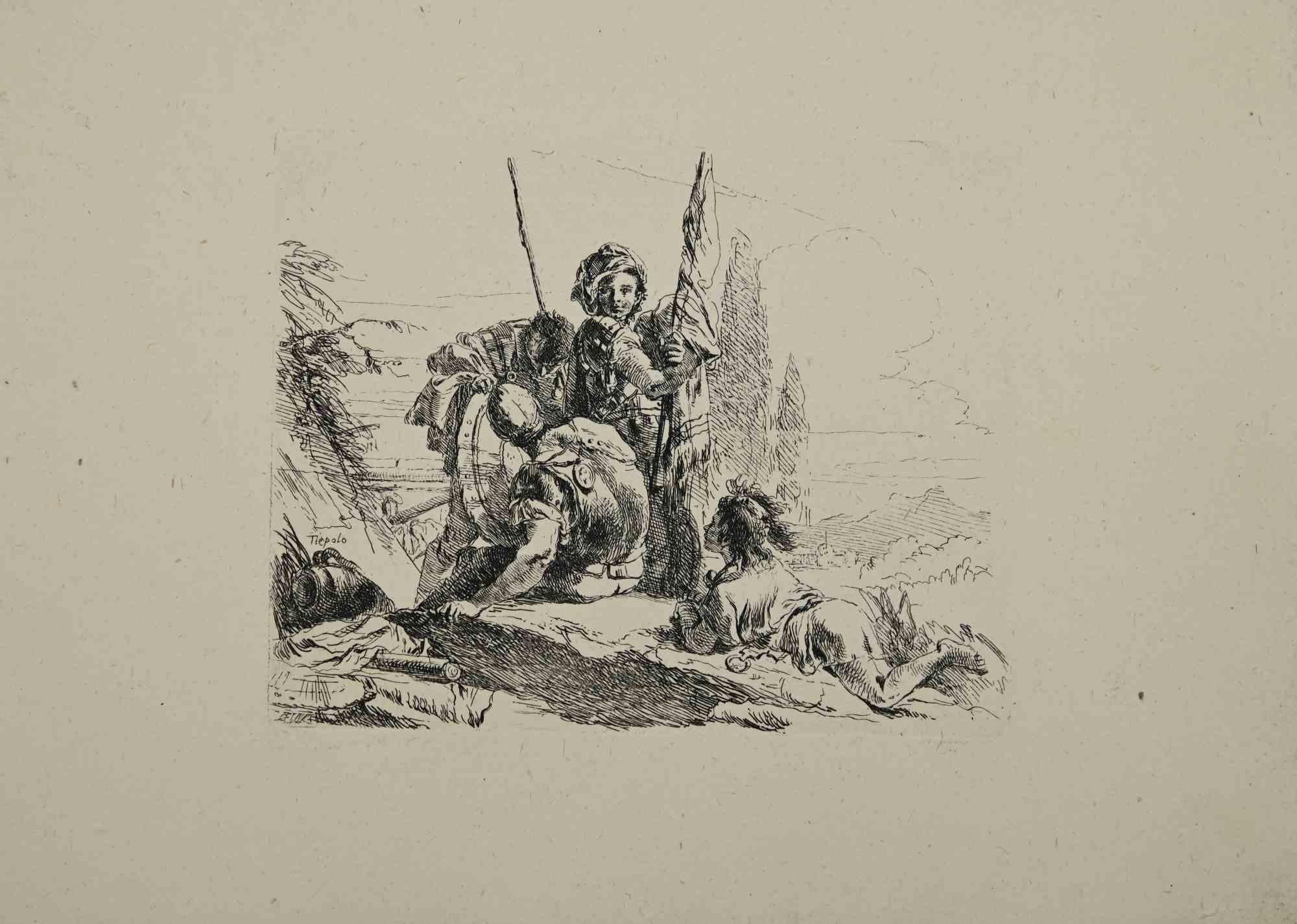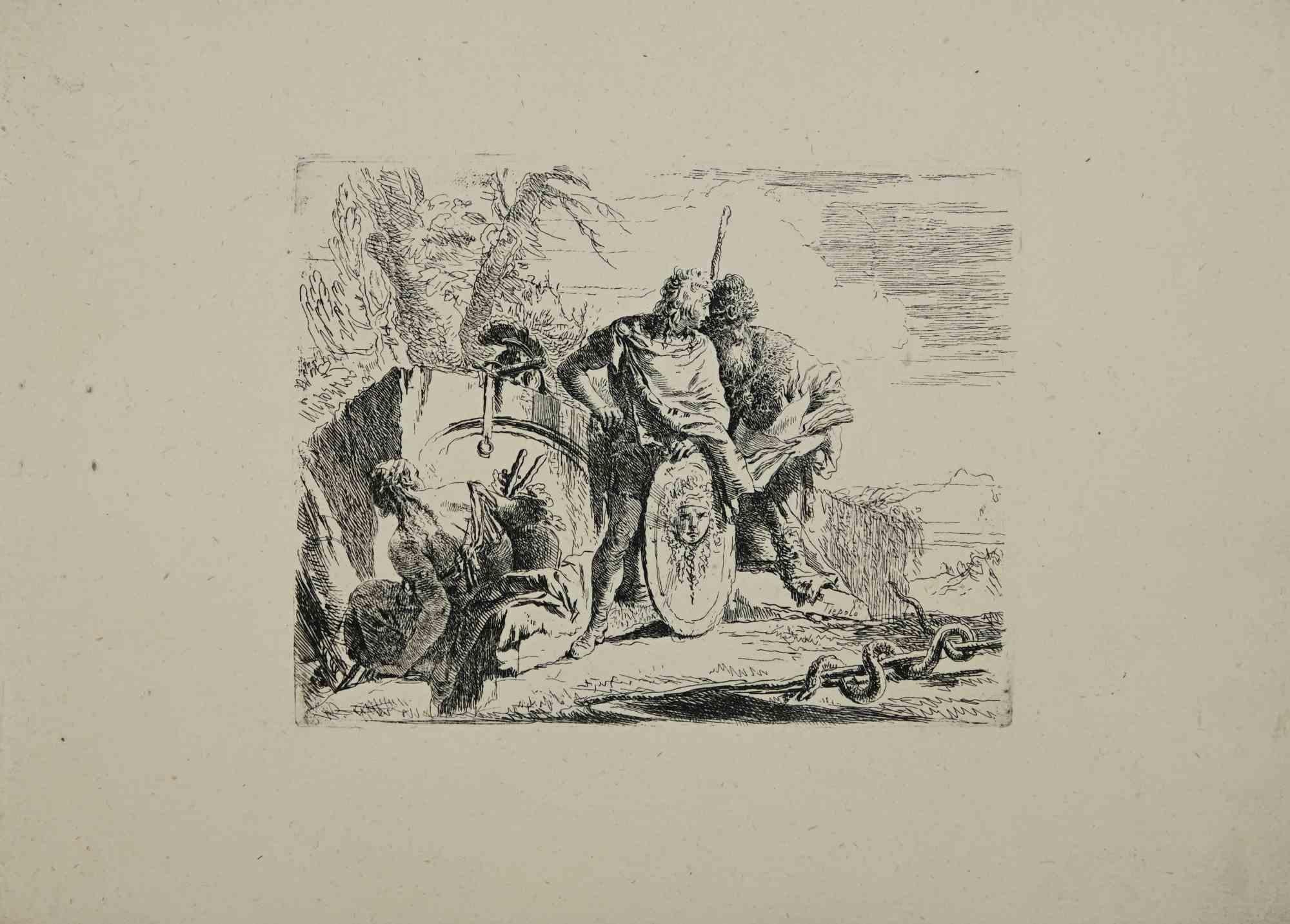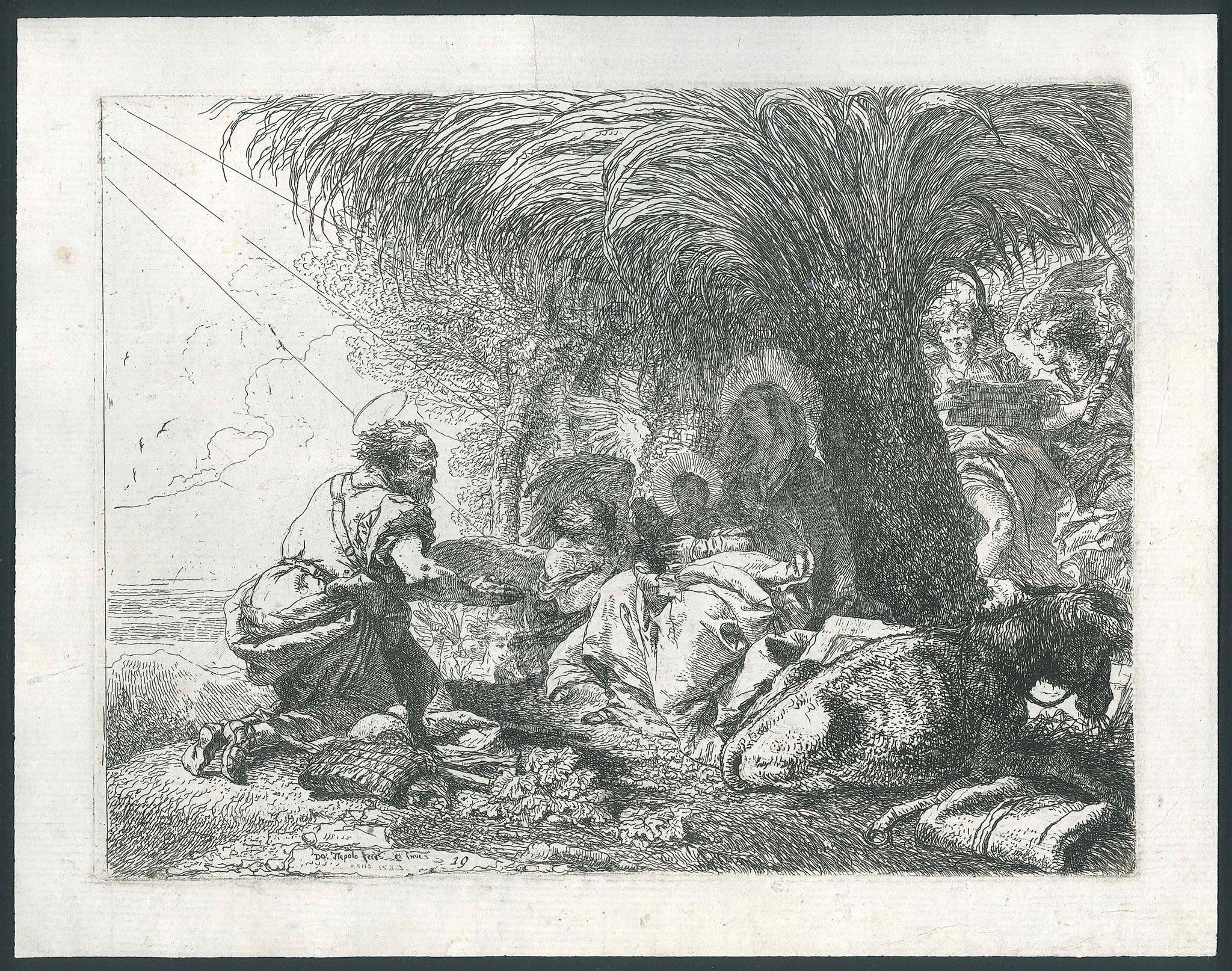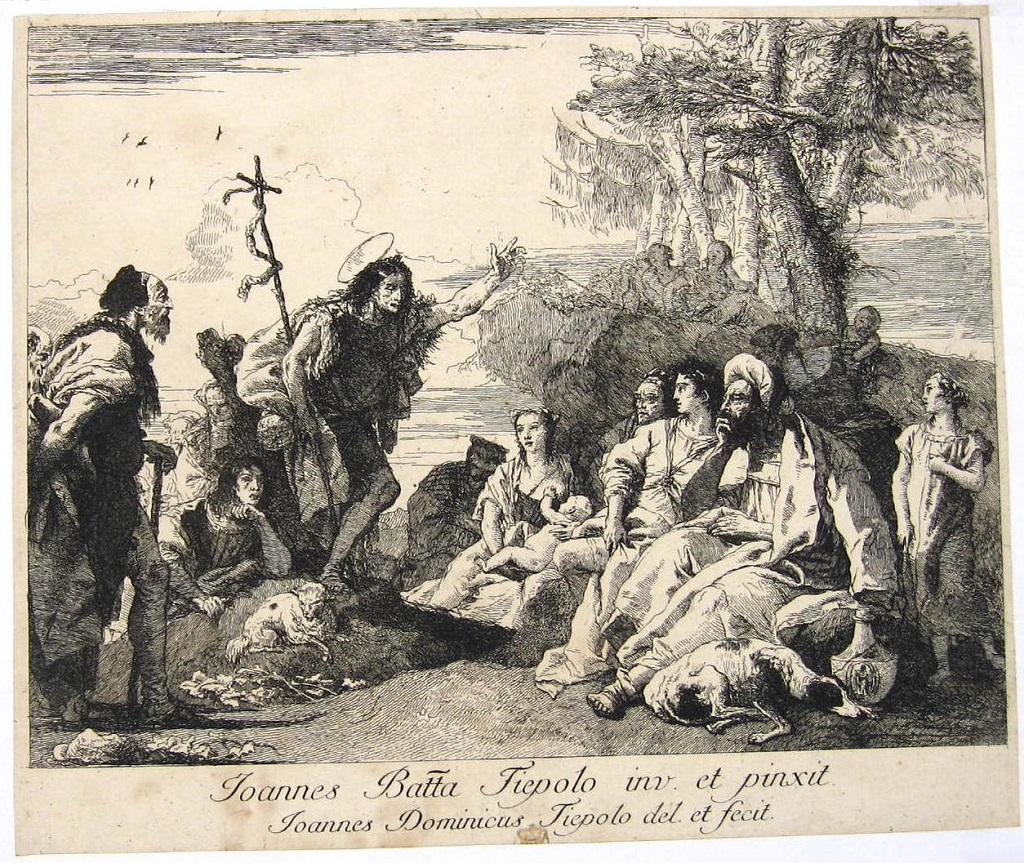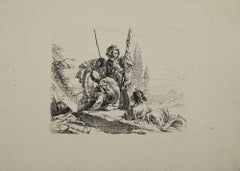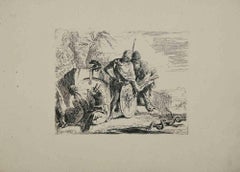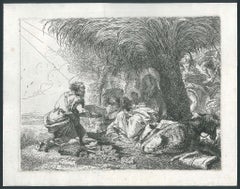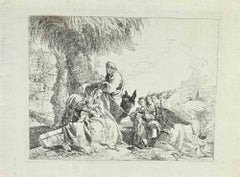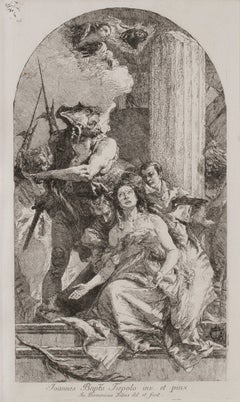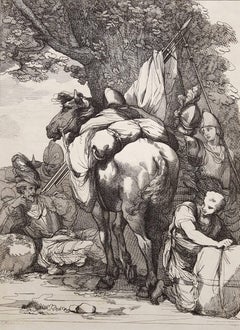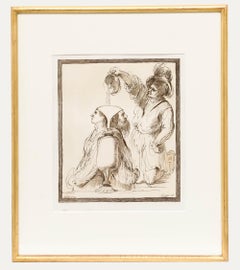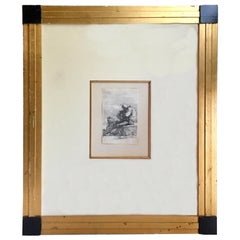Items Similar to Man and Soldier with an Urn - Etching by G.B. Tiepolo - 1785
Want more images or videos?
Request additional images or videos from the seller
1 of 2
Giovanni Battista TiepoloMan and Soldier with an Urn - Etching by G.B. Tiepolo - 17851785
1785
$3,101.57
£2,293.03
€2,600
CA$4,266.16
A$4,742.10
CHF 2,485.71
MX$57,912.57
NOK 31,032.65
SEK 29,195.93
DKK 19,793.76
About the Item
Man and soldier with an urn is an etching realized by Giambattista Tiepolo in 1785.
A woman looks out of the print. Two characters, a man and a soldier, are in front of a funeral element.
Sheet 23 x 30 cm.
Good impressions on paper, with wide margins.
Reference: De Vesme, 3/10; Rizzi 29/38. Succi 41/50.
It belongs to the edition of "Varii Capriccj" dedicated to Girolamo Manfrin. This is the only edition which was issued as a stand-alone publication. Following Rutgers, the realization of the series was realized between 1733 and 1735.
One of the most celebrated painters of eighteenth-century in Italy, Giovanni Battista Tiepolo (1696-1770) began making prints with his first collection of ten etchings, known as the Varj Capriccj: a very personal response to the production by Salvator Rosa and Giovanni Benedetto Castiglione . The prints don't have any straightforward or overt meanings, surely several prints evoke the ancient or Arcadian world, with classical urns, figures alongside tombstones, and fragments of obelisks; in one plate, the figure of Death was reading a book, faced by a group of the living.
Tiepolo’s Vari Capricci received with great acclaim among collectors and connoisseurs, thanks to their technical virtuosity and to their enigmatic meanings, a mark of his brilliance and a successful and personal declension of the “capriccio”. In 1774 Pierre-Jean Mariette wrote about Tiepolo: “ Rich and fertile genius … it shines above all in his prints ’'.
- Creator:Giovanni Battista Tiepolo (1696 - 1770, Italian)
- Creation Year:1785
- Dimensions:Height: 9.06 in (23 cm)Width: 12.6 in (32 cm)Depth: 0.04 in (1 mm)
- Medium:
- Movement & Style:
- Period:1780-1789
- Condition:Insurance may be requested by customers as additional service, contact us for more information.
- Gallery Location:Roma, IT
- Reference Number:Seller: T-1427451stDibs: LU650313198922
About the Seller
4.9
Platinum Seller
Premium sellers with a 4.7+ rating and 24-hour response times
1stDibs seller since 2017
7,682 sales on 1stDibs
Typical response time: 3 hours
- ShippingRetrieving quote...Shipping from: Roma, Italy
- Return Policy
Authenticity Guarantee
In the unlikely event there’s an issue with an item’s authenticity, contact us within 1 year for a full refund. DetailsMoney-Back Guarantee
If your item is not as described, is damaged in transit, or does not arrive, contact us within 7 days for a full refund. Details24-Hour Cancellation
You have a 24-hour grace period in which to reconsider your purchase, with no questions asked.Vetted Professional Sellers
Our world-class sellers must adhere to strict standards for service and quality, maintaining the integrity of our listings.Price-Match Guarantee
If you find that a seller listed the same item for a lower price elsewhere, we’ll match it.Trusted Global Delivery
Our best-in-class carrier network provides specialized shipping options worldwide, including custom delivery.More From This Seller
View AllTwo Soldiers - Etching by G.B. Tiepolo - 1785
By Giovanni Battista Tiepolo
Located in Roma, IT
Two soldiers is an etching realized by Giambattista Tiepolo, in 1785.
Sheet 23 x 30 cm.
Good impressions on paper, with wide margins.
Referenc...
Category
1780s Old Masters Figurative Prints
Materials
Etching
Two Soldiers - Etching by G.B. Tiepolo - 1795
By Giovanni Battista Tiepolo
Located in Roma, IT
Two soldiers is an etching realized by Giambattista Tiepolo in 1785.
Sheet 23 x 30 cm.
Good impressions on paper, with wide margins.
Reference: D...
Category
1790s Old Masters Figurative Prints
Materials
Etching
Giuseppe Adora il Bambino sotto una Palma - Etching by G.D. Tiepolo
By Giovanni Domenico Tiepolo
Located in Roma, IT
Black and white etching and burin on wire rod paper. Second and final state, after the numbering. Signed, numbered and dated on the lower left margin of plate. 19° plate from the ser...
Category
1750s Old Masters Figurative Prints
Materials
Etching
Rest on the Flight into Egypt - Etching by Giambattista Tiepolo - 1750
By Giovanni Battista Tiepolo
Located in Roma, IT
This etching on laid paper is the 13th plate of the series of 27 entitled Idee pittoresche sopra la fugga in Egitto di Giesù, Maria e Gioseppe executed by Giambattista Tiepolo and pu...
Category
1780s Old Masters Figurative Prints
Materials
Etching
La Predicazione di S. Giovanni Battista - Etching by Tiepolo - 18th Century
By Giovanni Domenico Tiepolo
Located in Roma, IT
La Predicazione di San Giovanni Battista is an original etching realized by Giovanni Domenico Tiepolo (Venice, 1727-1804) in the Second Half of the 18th Century.
Original Black and white etching and burin on paper. 1st state on 2, fresh and lively Impression.
Dimensions: 230 x 275 mm.
Wonderful etching in excellent impression, very fresh and bright, in a vibrant black ink, wide margins. Some minor stains, some minor folds and a little fold on the lower right margin.
Excellent conditions.
Ref: Rizzi 108, Prouté no. 163, 1981.
Provenance: Ex Coll. Paul I Ermitage. Lugt 2061.
Giovanni Domenico Tiepolo (Venice, 1727-1804). Tiepolo was an Italian painter and printmaker, mastering the art of etching. He is well known wolrdwide as he assisted his father in Wurzburg (Germany), he made stairwell fresco in Vicenza (Italy) and at the Palace of Charles III in Madrid (Spain). La Via Crucis is among the earliest works engraved by Giandomenico Tiepolo, just about twenty years old, where he translates into etchings the namesake series of paintings realised for the oratory...
Category
18th Century Modern Figurative Prints
Materials
Etching
Maria Viene Aiutata da un Angelo - Etching by G.D. Tiepolo - 1753
By Giovanni Domenico Tiepolo
Located in Roma, IT
Maria viene aiutata da un Angelo is an original Artwork realized by Giovanni Domenico Tiepolo (Venice, 1727-1804) in 1753.
Original Black and white etching and burin on paper.
This is the 18th plate of a series of 24 engravings by Giandomenico Tiepolo for Carlo Filippo, Prince of Greinffenklau, in which the same theme, that of the Flight into Egypt, is represented in a new and original way for each sheet.
The series entitled "Pictorial Ideas on the Flight into Egypt of Jesus, Mary and Joseph" and published in 1753 in Würzburg is considered the etching masterpiece of the old master Giandomenico Tiepolo.
Dimensions: 185 x 240 mm.
Wonderful etching in excellent impression, very fresh and bright, in a vibrant black ink.
Very good conditions.
Reference: D.V. no. 18; R. no. 84; Proutè no. 180, 1977.
Giovanni Domenico Tiepolo (Venice, 1727-1804). Tiepolo was an Italian painter and printmaker, mastering the art of etching. He is well known wolrdwide as he assited his father in Wurzburg (Germany), he made stairwell fresco in Vicenza (Italy) and at the Palace of Charles III in Madrid (Spain). La Via Crucis is among the earliest works engraved by Giandomenico Tiepolo, just about twenty years old, where he translates into etchings the namesake series of paintings realised for the oratory...
Category
1750s Modern Figurative Prints
Materials
Etching
You May Also Like
The Martyrdom of Saint Agatha
By Giovanni Domenico Tiepolo
Located in Fairlawn, OH
The Martyrdom of Saint Agatha
after the painting by his father, Giovanni Battista Tiepolo (see photo)
Etching, c. 1780
Signature: unsigned
Watermark: Letter A (similar to Bromberg 4...
Category
1780s Baroque Figurative Prints
Materials
Etching
Packhorse and Soldiers /// Antique British Victorian Etching Figurative Animal
By John Hamilton Mortimer
Located in Saint Augustine, FL
Artist: (after) John Hamilton Mortimer (English, 1740-1779)
Title: "Packhorse and Soldier"
Year: 1783
Medium: Original Etching on watermarked laid paper
Limited edition: Unknown
Prin...
Category
1780s Pre-Raphaelite Animal Prints
Materials
Etching, Laid Paper, Intaglio
James Basire after Guercino - Framed 18th Century Etching, Study of Janus
Located in Corsham, GB
Original etching. 'Janus' the Roman Two-Faced God of Duality Beginnings and Endings. Signed in plate. Well presented in a white card mount and gilt-effect frame. On paper.
Category
Early 18th Century Portrait Prints
Materials
Etching
Fine 17th Century Italian Etching by Salvator Rosa, 1615-1673
By Salvator Rosa
Located in Vero Beach, FL
Salvator Rosa, the Italian Baroque painter was also a significant etcher and printmaker. Rosa’s is series of small prints of soldiers was very popular and influential. This etching i...
Category
Antique 17th Century Italian Baroque Prints
Materials
Paper
$630 Sale Price
40% Off
Old Master Etching and Aquatint
By Francisco De Goya
Located in Tarrytown, NY
Plate #24 from Francisco de Goya's "Los Caprichos" series titled "Nohubo Remedio." Printed on wove paper. Double matted and contained under glass in an ebonized and parcel gilt wood ...
Category
Antique 19th Century Spanish Romantic Prints
Materials
Giltwood, Paper
Ancient Roman Marble Vase: 18th C. Piranesi Etching Vaso Cinerario di Gran Mole
By Giovanni Battista Piranesi
Located in Alamo, CA
"Vaso Cinerario di Gran Mole. Le Teste dei Giovenchi mostrano di reggere it pesante Festone composto di Frutti Fiori Grans ed use. Il tuto Necefsario all Vita Umana. Il Restante degl...
Category
1760s Old Masters Figurative Prints
Materials
Etching
More Ways To Browse
Urns Face
Ancient Urn
Urn Prints
Antique Tombstone
Antique Book Reading Stand
Tiepolo Etching
Chinese Wall Paper Screen
Contemporary High Relief Wall Sculpture
Felix Vallotton
Femme Nue
Goupil Prints
Le Chapeau
Leonard Baskin Woodcut
Miro Spanish Dancer
Mucha Sarah Bernhardt
Picasso Lithograph Dove Of Peace
Sarah Bird
Vintage Maurice Dress
